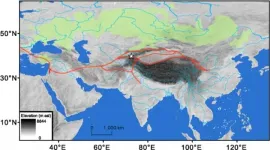A (pollen-free) sigh of relief for Japan: The genetics of male sterility in cedar trees
New study reveals that selective breeding of male-sterile Japanese cedar trees using genetic screening can help reduce pollen load and associated allergies
2021-02-17
(Press-News.org) Cryptomeria japonica, or the Japanese cedar, is highly revered as the national tree of Japan. Locally known as "sugi," it covers over 4.5 million hectares of land, accounting for nearly half of Japan's artificial forests. However, it is also notorious for causing hay fever, with a good 26.5% of Japan's population reporting cedar pollen allergies in 2008. Over the past years, pollen allergy caused by this conifer has become a widespread social issue among Japanese residents, with many having to avoid going outdoors during pollen season.
As sterile trees cannot produce and release functional pollen, it is believed that breeding of male-sterile cedar trees could be crucial in reducing the pollen released into the environment. However, their frequency is drastically low, with only two male-sterile trees per 8700 trees in a forest! The rarity of these trees, combined with the large and repetitive genomes of conifers, has made decoding the genes involved in their reproduction (and the lack thereof) a challenge.
Recently, a team of researchers including Dr. Yoichi Hasegawa, Dr. Fu-Jin Wei, and Dr. Saneyoshi Ueno from the Forestry and Forest Products Research Institute (FFPRI) in Japan, along with Dr. Yoshinari Moriguchi from Niigata University, identified a candidate for the "Male Sterility" (MS1) gene in C. japonica and investigated the applications of selectively breeding male-sterile trees as a means to reduce the pollen load. Their findings have been published in the journal Scientific Reports.
Discussing their findings, Dr. Hasegawa says, "We have identified a candidate gene and two deleterious mutations underlying male sterility in sugi trees. The mutants can be easily detected using polymerase chain reaction (PCR) at the seedling stage without observing tree phenotypes (the outward appearance or manifestation), thereby accelerating the breeding of male-sterile sugi."
The team first examined genetic mutations in trees with ms1 alleles from strobili, the cone-like structures that bear pollen, using RNA sequencing analysis. The recessive "allele" (one of the two inherited "copies" of a gene), "ms1," has been associated with male sterility in Japanese cedars because it causes defective formation of microspores--the male gamete required for breeding. They identified a candidate gene for male sterility, called CJt020762. They also identified two deletion mutations within this gene that were consistently found in male-sterile trees. Using these two mutations as markers, the team developed a simple PCR-based screening strategy to detect these mutations and rapidly propagate male-sterile seedlings.
Further, Dr. Hasegawa and his team established a "haplotype network" with trees across 18 natural forests in Japan. Describing how the pattern and variation of genetic alterations in the specified gene influence ancestry, Dr. Hasegawa states, "Phylogeographic analysis of the mutants demonstrates that they share a close common ancestor whose haplotype is distributed throughout Japan, suggesting that new breeding materials with the mutant haplotype will be found in various regions under different environmental conditions."
Their findings provide useful insights into the molecular mechanisms underlying male sterility in conifers and highlights the importance of genetic markers in pollen production. With the help of these markers, selective breeding of male-sterile trees could gradually but eventually replace fertile conifers in artificial forests. This has the potential to substantially reduce the amount of dispersed pollen and the allergies associated with it.
In conclusion, Dr Hasegawa remarks, "Our study identifies the functional gene behind male sterility in conifers for the first time, establishing the model of reproductive genetics in sugi. Increased breeding of male-sterile sugi seedlings in the artificial forests will be easier using genetic screening, gradually replacing fertile trees with male-sterile ones. Probably in the next 50 years, many people with pollen allergy will be relieved to step outdoors in spring owing to the increasing number of male-sterile cedar trees and the eventual decrease in airborne pollen."
The study is indeed a step forward towards carefree--and pollen-free--breathing for people in Japan and even the world over!
INFORMATION:
Reference
Title: Identification and genetic diversity analysis of a male sterile gene (MS1) in Japanese cedar (Cryptomeria japonica D. Don)
Journal: Scientific Reports
Link (open access): https://doi.org/10.1038/s41598-020-80688-1
About Forestry and Forest Products Research Institute, Japan
Inaugurated as a unit for forest experiments in Tokyo in 1905, the Forestry and Forest Products Research Institute (FFPRI) was largely reorganized in 1988, when it received its current name. During its history of over 110 years, the FFPRI has been conducting interdisciplinary research on forests, forestry, the timber industry, and tree breeding with an agenda based around sustainable development goals. The FFPRI is currently looking to collaborate with more diverse stakeholders, such as international organizations, government agencies, and industry and academic leaders, to conduct much needed forest-related research and make sure we preserve these renewable resources.
Website: https://www.ffpri.affrc.go.jp/ffpri/en/index.html
About Dr. Yoichi Hasegawa from Forestry and Forest Products Research Institute, Japan
Dr. Yoichi Hasegawa is currently a senior researcher at the Tree Genetic Lab in Forestry and Forest Products Research Institute, Japan. His research interests include the identification and characterization of genetic markers in plants and marker assisted selection of reproductive traits and pollen production. Dr. Hasegawa has authored several publications in peer reviewed journals in the area of plant genetics.
Funding information
This study was supported by research grants #201421 from the Forestry and Forest Products Research Institute, Grant-in-Aid from the Program for Promotion of Basic and Applied Researches for Innovations in Bio-oriented Industry (No.28013B), the project of the NARO Bio-oriented Technology Research Advancement Institution (Research program on development of innovative technology, No.28013BC), and NIBB Collaborative Research Program (16-403, 17-405 and 18-408).
[Attachments] See images for this press release:

ELSE PRESS RELEASES FROM THIS DATE:
2021-02-17
A team of MedUni Vienna researchers led by Johannes A. Schmid at the Center for Physiology and Pharmacology, Institute of Vascular Biology and Thrombosis Research, has managed to identify a previously unknown molecular connection between an inflammatory signalling molecule and one of the main oncogenes. The study has been published in the leading journal "Molecular Cancer".
Johannes A. Schmid's working group at the Center for Physiology and Pharmacology, Institute of Vascular Biology and Thrombosis Research, already has many years' experience in the molecular ...
2021-02-17
The Silk Road was the most elaborate network of trade routes in the ancient world, linking ancient populations in East Asia to those in southwest Asia, via Central Asia. These trade routes fostered the spread of ideas, religions, and technologies over the past 2,000 years. Before the establishment of organized exchange, starting around the time of the Chinese Han Dynasty (2,223 years ago), a process of trans-Eurasian exchange was already underway through the river valleys and oases of Central Asia. The establishment of populations in the oases of the Taklimakan Desert ...
2021-02-17
Cardiovascular system can be regarded as a mechanical system centered on the heart. Blood flow in the vascular system, hemodynamics factors within the vasculature contain wall shear stress, circumferential wall tensile stress and hydrostatic pressure. Mechanical forces play an important role in vasculature and circulation, such as rapid regulation of vascular wall elasticity, administration of vascular remodeling, and the formation of arteriosclerotic lesions. Stress stimulation within the physiological range enables cells in dynamic balance to maintain homeostasis of vascular morphology, structure and function. Inversely, abnormal stresses stimulation, such as low shear stress, disturbed shear stress and high tensile strain, can break this balance ...
2021-02-17
More people than expected ended their own lives in 2020 in Japan, overturning a decadelong slow decline in the nation's annual number of suicides, according to a new analysis by public health experts at the University of Tokyo. The increase in suicides was especially pronounced among women younger than 30, potentially due to the COVID-19 pandemic's disproportionate effect on part-time and travel industry employees.
"This trend of increased suicides among young women and university and high school students is very different from before COVID-19. Before COVID-19, if suicides increased, we would expect more deaths of middle-aged men," said Dr. Haruka Sakamoto, an expert in public health at the University of Tokyo and first author of the research publication in the Journal of the ...
2021-02-17
After seven years of intense research, a research group from Aarhus University has succeeded - through an interdisciplinary collaboration - in understanding why a very extended structure is important for an essential protein from the human immune system. The new results offer new opportunities for adjusting the activity of the immune system both up and down. Stimulation is interesting in relation to cancer treatment, while inhibition of the immune system is used in treatment of autoimmune diseases.
In our bloodstream and tissues, the complement system acts as one of the very first defense mechanisms against pathogenic organisms. When these are ...
2021-02-17
People with asthma in the most deprived areas are 50% more likely to be admitted to hospital and to die from asthma compared with those in the least deprived areas, a new five-year study of over 100,000 people in Wales has revealed.
Those from more deprived backgrounds were also found to have a poor balance of essential asthma medications that help prevent asthma attacks.
The new research, published in the journal PLOS Medicine, was conducted by Swansea University's Wales Asthma Observatory in collaboration with Asthma UK Centre for Applied Research and Liverpool University, and found ...
2021-02-17
SAN FRANCISCO, CA--February 16, 2021--In people with central nervous system (CNS) lymphoma, cancerous B cells--a type of white blood cell--accumulate to form tumors in the brain or spinal cord, often in close proximity to blood vessels. This disease is quite rare, but individuals who are affected have limited treatment options and often experience recurrence.
Previous research has linked the severity of CNS lymphoma to abnormal leaks in the blood-brain barrier, a protective system that allows some substances to pass from the bloodstream to the brain, while blocking others. However, the specific molecular details of this link have been murky.
Now, Gladstone researchers have ...
2021-02-17
Tsukuba, Japan - It's tough out there in the sea, as the widespread loss of complex marine communities is testament to. Researchers from Japan have discovered that ocean acidification favors degraded turf algal systems over corals and other algae, thanks to the help of feedback loops.
In a study published this month in Communications Biology, researchers from the University of Tsukuba have revealed that ocean acidification and feedback loops stabilize degraded turf algal systems, limiting the recruitment of coral and other algae.
Oceans are undergoing widespread changes as a result of human activities. These changes take the form of regime shifts - major, sudden and persistent changes in ecosystem structure and function. An example is the replacement of coral reefs and kelp ...
2021-02-17
An estimated 1.1 billion people were living with untreated vision impairment in 2020, but researchers say more than 90 per cent of vision loss could be prevented or treated with existing, highly cost-effective interventions.
Published today in The Lancet Global Health, a new commission report on global eye health calls for eye care to be included in mainstream health services and development policies. It argues that this is essential to achieve the WHO goal of Universal Health Coverage (UHC) and the 2030 United Nations Sustainable Development Goals (SDGs).
Written by 73 leading experts from 25 countries, including University of ...
2021-02-17
FEBRUARY 15, 2021, NEW YORK - A Ludwig Cancer Research study has identified a novel mechanism by which a type of cancer immunotherapy known as CTLA-4 blockade can disable suppressive immune cells to aid the destruction of certain tumors. The tumors in question are relatively less reliant on burning sugar through a biochemical process known as glycolysis.
Researchers led by Taha Merghoub and Jedd Wolchok of the Ludwig Center at Memorial Sloan Kettering Cancer Center (MSK) and former postdoc Roberta Zappasodi--now at Weill Cornell Medicine--have discovered that in a mouse model of glycolysis-deficient tumors, CTLA-4 blockade does ...
LAST 30 PRESS RELEASES:
[Press-News.org] A (pollen-free) sigh of relief for Japan: The genetics of male sterility in cedar trees
New study reveals that selective breeding of male-sterile Japanese cedar trees using genetic screening can help reduce pollen load and associated allergies






